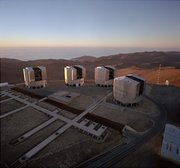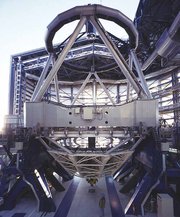Very Large Telescope
|
|
 The four telescopes of the European Southern Observatory Paranal site. The VLTI (Very Large Telescope Interferometer) building is the low structure in front of the telescopes. Image courtesy of the European Southern Observatory. | |
| Organization | European Southern Observatory |
|---|---|
| Location | Cerro Paranal, Atacama desert, Chile |
| Coordinates | Template:Coor dms |
| Altitude | 2,635 m |
| Weather | >340 clear nights/year |
| Webpage | Paranal observatory (http://www.eso.org/paranal/) |
| Telescopes | |
| Antu | 8,2 m reflector |
| Kueyen | 8,2 m reflector |
| Melipal | 8,2 m reflector |
| Yepun | 8,2 m reflector |

The Very Large Telescope Project (VLT) consists of a system of four separate optical telescopes (the Antu telescope, the Kueyen telescope, the Melipal telescope, and the Yepun telescope) organized in an array formation. Each telescope has an 8.2 m aperture. The project is organized by the European Southern Observatory.
VLT is located at the Paranal Observatory on Cerro Paranal, a 2,635 m high mountain in the Atacama desert in northern Chile.
| Contents |
General information
The VLT consists of a cluster of four large (8 meter diameter) telescopes, and an interferometer (VLTI) which will be used to resolve fine features. The interferometer will include a set of 1.8 meter diameter telescopes dedicated to interferometric observations. The 8 meter telescopes have been named after the names of some astronomical objects in the local Mapuche language: Antu (The Sun), Kueyen (The Moon), Melipal (The Southern Cross), and Yepun (Venus)
The VLT 8 meter telescopes can be operated in three modes:
- as a set of independent telescopes (this is the primary mode of operation)
- as a single large incoherent instrument, for extra light-gathering capacity (this mode has now been abandoned)
- as a single large coherent interferometric instrument (the VLT Interferometer or VLTI), for extra resolution (this is occasionally used, usually for observations of relatively bright sources)
The principle role of the VLT is to operate as four independent telescopes, and the interferometry (combining light from multiple telescopes) is a minor secondary role.
The VLT is operated by the European Southern Observatory.
In 2005, VLT telescopes produced some of the first infrared images of extrasolar planets GQ Lupi b and 2M1207b.
Interferometry and the VLTI
Most interferometry will be done using 1.8 meter Auxiliary Telescopes (ATs), which will be dedicated to full-time interferometric measurements. The first observations using a pair of ATs were conducted in February 2005, and additional ATs are expected to be installed soon. For many interferometric observations there is little benefit in using 8 meter telescopes rather than 1.8 meter telescopes.
In its full interferometric operating mode, the four telescopes provide the same light gathering ability (neglecting light losses from the throughput of the instrument) as a single 16 m telescope, making it theoretically the largest optical telescope in the world (the interferometric technique used at the VLTI is not suitable for observing very faint sources, so it actually has poorer sensitivity than the single 8m telescopes). The light from the telescopes is reflected off mirrors and directed through tunnels to a central beam combining laboratory. The VLT is intended to achieve an effective angular resolution of 0.001 arcsecond at a wavelength of 1 µm, comparable to that achieved using other arrays such as the Navy Prototype Optical Interferometer and the CHARA Array.
The poor brightness sensitivity of interferometric observations mean that they could not be used for imaging objects with low surface brightness such as the moon. Only targets which are at temperatures of more than 1000 °C have a surface brightness high enough to be observed in the mid-infrared, and objects must be at several thousands of degrees for near-infrared observations using the VLTI. This sensitivity limit rules out interferometric observations of most solar-system objects apart from the Sun. All the stars visible to the naked eye have temperatures of several thousand degrees, and have large enough surface brightnesses and angular sizes to be observed by the VLTI. Although the use of large telescope diameters and adaptive optics correction can improve the sensitivity a small amount, this cannot extend the reach of optical interferometry beyond nearby stars and the brightest active galactic nucleii.
The first two instruments at the VLTI were VINCI and MIDI, which only allowed two telescopes to be used at any one time. With the installation of the three-telescope AMBER closure-phase instrument in 2005, the first imaging observations from the VLTI are expected soon. In 2008 the PRIMA instrument will further enhance the imaging capabilities of the VLTI by allowing phase-referenced imaging.
After falling drastically behind schedule and failing to meet some specifications, in December 2004 the VLT Interferometer became the target of a second ESO recovery plan. This involves additional effort concentrated on more rapid improvements to fringe tracking and the performance of the main delay lines. Note that this only applies to the interferometer and not other instruments on Paranal.
See also
- List of observatories
- List of optical telescopes
- List of astronomical interferometers at visible and infrared wavelengths
- Overwhelmingly Large Telescope
- Giant Magellan Telescope
- Wikipedia Project: Telescopes
External links
- ESO VLT (http://www.eso.org/projects/vlt/) official site for the 8m telescopes.
- ESO VLTI (http://www.eso.org/projects/vlti/) official site for the interferometer (combining the telescopes)
- ASTROVIRTEL Accessing Astronomical Archives as Virtual Telescopes (http://www.stecf.org/astrovirtel/) including archives from the VLT
- Telescope to challenge moon doubters (http://www.smh.com.au/articles/2002/11/24/1037697982142.html) -- note description of VLTI is innaccuratede:Very Large Telescope
es:Very Large Telescope fr:Very Large Telescope it:Very Large Telescope nl:Very Large Telescope
